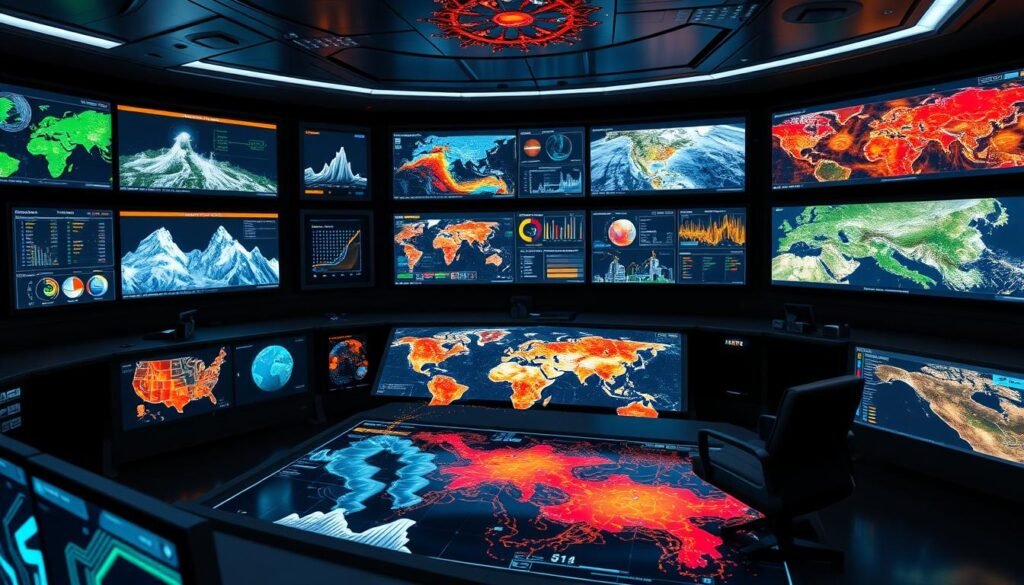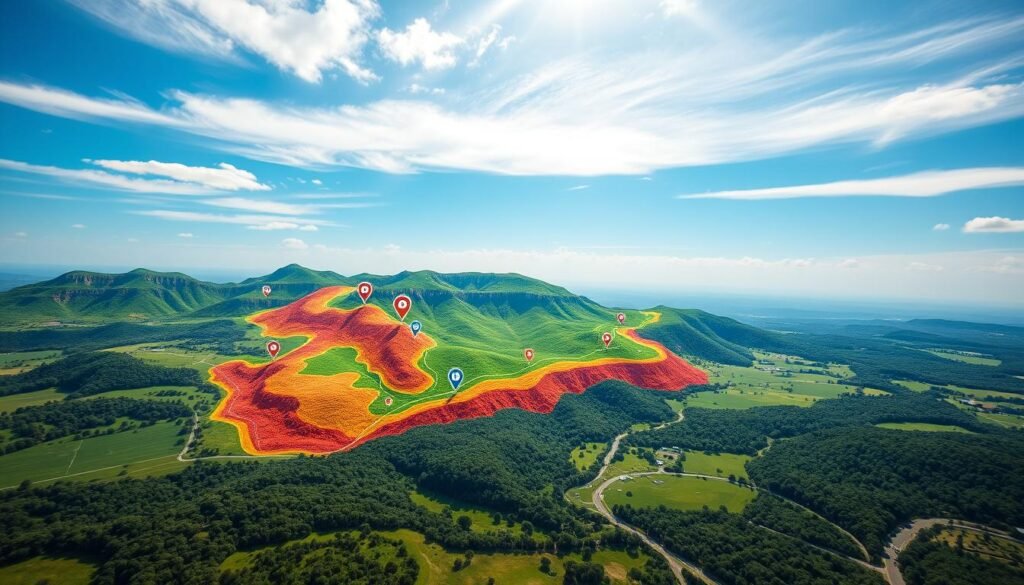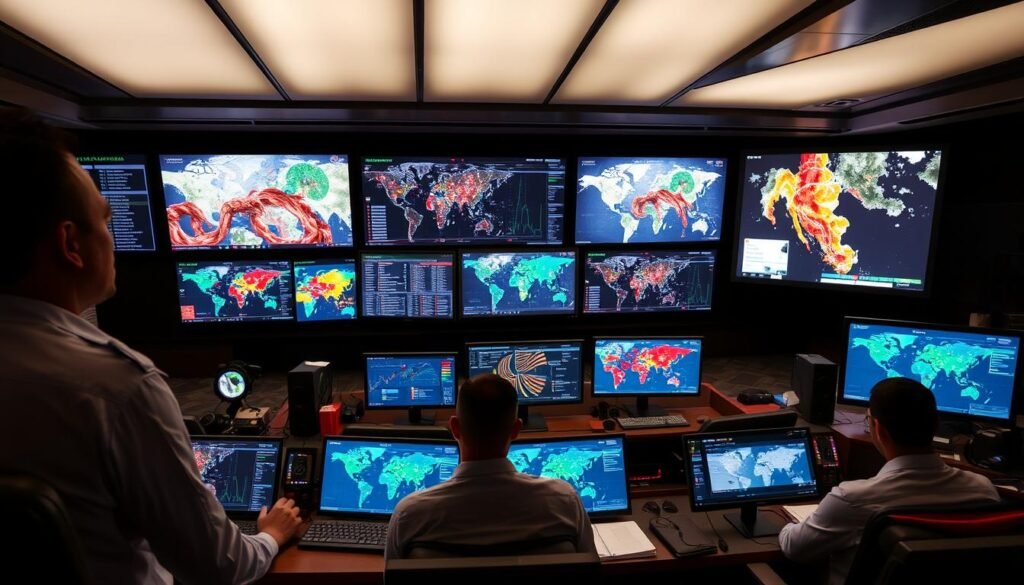AI in disaster
In today’s world, natural disasters and emergencies are more common than ever. We’re seeing a big change in how we handle these situations. Artificial intelligence (AI) is playing a key role, helping us predict, prepare for, and respond to emergencies better.

Our article looks at how AI is changing disaster preparedness, crisis communication, and emergency response in the U.S. We’ll see how machine learning helps spot disasters early and how natural language processing makes crisis communication smoother. These advancements are making a big difference in disaster management.
Key Takeaways
- AI technology is revolutionizing disaster prediction and management, enhancing safety and response efforts.
- Machine learning models are enabling early detection of impending disasters, allowing for timely preparedness.
- Natural language processing is improving crisis communication, ensuring critical information reaches the public effectively.
- Predictive analytics and geospatial analysis are empowering resource allocation and emergency response planning.
- AI-driven insights are optimizing evacuation routes and shelter management, saving lives during emergencies.
Harnessing the Power of AI Technology for Disaster Preparedness
We’re using artificial intelligence (AI) to stay ahead of natural disasters. AI helps us spot early warning signs and make accurate forecasts. This gives communities time to prepare and respond well.
Machine Learning Models for Early Detection
AI models look at lots of data, like weather and sensor readings. They find early signs of disasters like hurricanes and floods. This helps emergency teams get ready and warn people in time.
Natural Language Processing in Crisis Communication
Good communication is key in a crisis. AI’s natural language processing (NLP) changes how we share info. It looks at social media and emergency calls to find important details fast. This helps authorities give clear updates and keep people safe.
AI is making us better at disaster readiness and communication. It’s a game-changer for keeping our communities safe.
“AI technology is becoming an indispensable tool in our efforts to predict, prepare for, and respond to natural disasters.”
AI technology role in disaster prediction and management
So , AI technology is changing how we deal with disasters. It uses advanced analytics to help us get ready for, respond to, and recover from emergencies.
AI helps predict disasters by using machine learning models for early detection. These models look at lots of data, like sensor readings and weather forecasts. They spot threats early, giving warnings. This lets authorities act fast to prevent disasters.
Natural language processing is also key in crisis communication. AI chatbots and virtual assistants quickly answer public questions. They share vital info and updates, keeping people informed during emergencies.
- Leveraging AI for predictive analytics to forecast risks and mitigate impact
- Utilizing geospatial analysis and AI-driven insights to optimize resource allocation and emergency response planning
- Empowering decision-makers with AI-generated insights for more informed and effective disaster management strategies
As AI technology grows, we’ll see more ways it helps save lives and protect communities. It will help us face natural and man-made disasters better.

Predictive Analytics: Forecasting Risks and Mitigating Impact
In disaster management, predictive analytics has changed the game. It uses big data and AI to predict natural disasters’ chances and effects. This helps communities prepare and mitigate risks, saving lives and reducing damage.
At the core is analyzing past data and weather to create risk assessment models. These AI systems forecast disasters like hurricanes, floods, and wildfires. With this info, leaders can plan evacuations, allocate resources, and strengthen buildings, keeping communities safe.
| Disaster Type | Predictive Accuracy | Lead Time |
|---|---|---|
| Hurricanes | 88% | 3-7 days |
| Floods | 75% | 1-3 days |
| Wildfires | 82% | 2-5 days |
| Earthquakes | 68% | 1-2 hours |
This technology’s impact is huge. It lets communities plan better, choose evacuation routes, and stock up on supplies. This shift from reacting to preventing is making our communities safer and more resilient.
“Predictive analytics has revolutionized the way we manage natural disasters, allowing us to anticipate and mitigate their impact with unprecedented precision.”
As we keep using predictive analytics, disaster management’s future looks promising. These advanced systems give us insights to build a stronger, more ready world. We can face whatever nature throws our way.

Geospatial Analysis and Resource Allocation
We can now change disaster management with AI technology. Geospatial analysis helps us find high-risk areas and map vulnerabilities. It also lets us use resources better than ever before.
Mapping Vulnerabilities with AI
AI uses data from many sources like satellite images and census records. It helps us make detailed risk assessments. This guides us to place emergency supplies and shelters where they’re most needed.
This tech is great for finding the most vulnerable areas. Geospatial analysis shows us where people are most at risk. It helps us send resources to where they’re needed most.
Data mining also helps us understand disaster patterns. It uses past data and current info to predict future risks. This lets us prepare better and protect our communities.
“Geospatial analysis and resource allocation powered by AI are transforming the way we approach disaster management, allowing us to be better prepared and more resilient in the face of unpredictable challenges.”

Emergency Response Planning with AI-Driven Insights
Natural disasters and emergencies need quick and effective planning to save lives and reduce damage. AI technology is changing emergency response planning. It offers insights that help plan evacuation routes, manage shelters, and allocate resources better.
Optimizing Evacuation Routes and Shelter Management
AI looks at real-time data like traffic, population, and infrastructure to help plan evacuations. This makes emergency responses faster and more effective, saving lives.
AI finds the best evacuation routes by checking road conditions, traffic, and where vulnerable people are. This helps get people to safety quickly, avoiding traffic jams and chaos.
AI also helps manage emergency shelters. It looks at space, resources, and what evacuees need. This ensures shelters have what they need to support people.

Leveraging Data for Effective Resource Allocation
After a disaster, using resources well is key to helping communities. AI uses data mining and predictive analytics to find where help is most needed.
- AI looks at social media, emergency calls, and satellite images to see where damage is.
- This info helps decide where to send food, water, and medical supplies first.
- AI also makes logistics and transport better to get these supplies where they’re needed faster.
AI-driven insights make emergency planning smarter, faster, and more effective. This saves lives and lessens the disaster’s impact on communities.
Conclusion
AI technology is changing how we predict and manage disasters. It uses advanced analytics and machine learning to help us spot dangers early. This makes crisis communication better and helps us use resources wisely during emergencies.
AI is key in fighting the effects of climate change and extreme weather. It helps us understand risks and plan better for disasters. AI also improves emergency response planning and finds the best evacuation routes.
As we look to the future, AI’s role in disaster management will grow. By using these new tools, we can protect our communities better. We can build a safer and more resilient world for everyone.
FAQ
How is AI technology transforming disaster prediction and management?
AI is changing disaster prediction and management in many ways. It helps with early detection and risk assessment. It also improves resource allocation and emergency response planning.
By using advanced analytics, AI is changing how we get ready for, respond to, and recover from disasters.
What are the key applications of AI in disaster preparedness?
AI is making disaster prediction better by analyzing lots of data. This includes weather patterns, historical records, and real-time sensor data.
AI algorithms can spot early warning signs and give accurate forecasts. This gives communities and emergency responders more time to act.
AI also helps with crisis communication. It uses social media, news reports, and emergency call logs to analyze and respond quickly.
How does AI-driven predictive analytics contribute to risk assessment and impact forecasting?
AI-driven predictive analytics are changing how we assess risks and forecast impacts. They analyze historical data, weather patterns, and other factors.
AI models can predict the likelihood and severity of disasters. This helps communities take steps to reduce damage and loss of life.
What role does geospatial analysis and resource allocation play in disaster management?
AI-powered geospatial analysis is key in disaster management. It helps identify high-risk areas and map vulnerabilities.
AI combines data from satellites, census records, and infrastructure to create detailed risk assessments. This guides decision-makers in placing emergency supplies and shelters.
How is AI enhancing emergency response planning?
AI is changing emergency response planning by using data to make better decisions. It helps plan evacuation routes, manage shelters, and distribute resources.
AI analyzes real-time data on traffic, population, and infrastructure. This ensures emergency responses are timely and effective, saving lives.



